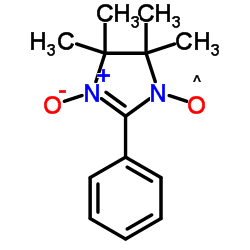3-氧代-2-苯基-4,4,5,5-四甲基咪唑啉-1-氧

3-氧代-2-苯基-4,4,5,5-四甲基咪唑啉-1-氧结构式

|
常用名 | 3-氧代-2-苯基-4,4,5,5-四甲基咪唑啉-1-氧 | 英文名 | PTIO |
|---|---|---|---|---|
| CAS号 | 18390-00-6 | 分子量 | 233.286 | |
| 密度 | 1.17g/cm3 | 沸点 | 359.7ºC at 760mmHg | |
| 分子式 | C13H17N2O2 | 熔点 | N/A | |
| MSDS | 中文版 美版 | 闪点 | 171.3ºC |
|
Nitric oxide induces cancer stem cell-like phenotypes in human lung cancer cells.
Am. J. Physiol. Cell Physiol. 308(2) , C89-100, (2015) Even though tremendous advances have been made in the treatment of cancers during the past decades, the success rate among patients with cancer is still dismal, largely because of problems associated with chemo/radioresistance and relapse. Emerging evidence h... |
|
|
Interaction of nNOS with PSD-95 negatively controls regenerative repair after stroke.
J. Neurosci. 34(40) , 13535-48, (2014) Stroke is a major public health concern. The lack of effective therapies heightens the need for new therapeutic targets. Mammalian brain has the ability to rewire itself to restore lost functionalities. Promoting regenerative repair, including neurogenesis an... |
|
|
Cardiac contractility in Antarctic teleost is modulated by nitrite through xanthine oxidase and cytochrome p-450 nitrite reductase.
Nitric Oxide 49 , 1-7, (2015) In mammalian and non-mammalian vertebrates, nitrite anion, the largest pool of intravascular and tissue nitric oxide storage, represents a key player of many biological processes, including cardiac modulation. As shown by our studies on Antarctic teleosts, ni... |
|
|
Decreased miR122 in hepatocellular carcinoma leads to chemoresistance with increased arginine.
Oncotarget 6 , 8339-52, (2015) Reduced expression of microRNA122 (miR122), a liver-specific microRNA, is frequent in hepatocellular carcinoma (HCC). However, its biological significances remain poorly understood. Because deregulated amino acid levels in cancers can affect their biological ... |
|
|
Endothelial Cells Promote Pigmentation through Endothelin Receptor B Activation.
J. Invest. Dermatol. 135 , 3096-104, (2015) Findings of increased vascularization in melasma lesions and hyperpigmentation in acquired bilateral telangiectatic macules suggested a link between pigmentation and vascularization. Using high-magnification digital epiluminescence dermatoscopy, laser confoca... |
|
|
Nitric oxide mediates cell aggregation and mesenchymal to epithelial transition in anoikis-resistant lung cancer cells.
Mol. Cell Biochem. 393(1-2) , 237-45, (2014) Cancer cell aggregation has been long known to facilitate metastatic potential of cancer cells. In addition, the presence of nitric oxide (NO) in cancer area may have a significant impact on aggregation behavior of the cells. We show herein that lung cancer H... |
|
|
Melanoma differentiation associated gene-7/interleukin-24 induces caspase-3 denitrosylation to facilitate the activation of cancer cell apoptosis.
J. Interferon Cytokine Res. 35(3) , 157-67, (2015) Melanoma differentiation-associated gene-7 (mda-7)/interleukin-24 (IL-24) induces caspase-3 cleavage and subsequent activation via the intrinsic or extrinsic pathway to result in cancer cell-selective apoptosis, but whether mda-7/IL-24 may directly regulate c... |
|
|
Nitric oxide induces apoptosis in human gingival fibroblast through mitochondria-dependent pathway and JNK activation.
Int. Endod. J. 48(3) , 287-97, (2015) To investigate the molecular mechanisms of nitric oxide (NO)-induced cytotoxic effect in human gingival fibroblast (HGF) cells.After sodium nitroprusside (SNP), as NO donor, was treated to HGF, viability was measured by MTT assay and apoptosis was determined ... |
|
|
Tipping off endothelial tubes: nitric oxide drives tip cells.
Angiogenesis 18(2) , 175-89, (2015) Angiogenesis, the formation of new blood vessels from pre-existing vessels, is a complex process that warrants cell migration, proliferation, tip cell formation, ring formation, and finally tube formation. Angiogenesis is initiated by a single leader endothel... |
|
|
Nitric oxide mediates bleomycin-induced angiogenesis and pulmonary fibrosis via regulation of VEGF.
J. Cell. Biochem. 116 , 2484-93, (2015) Pulmonary fibrosis is a progressive lung disease hallmarked by increased fibroblast proliferation, amplified levels of extracellular matrix deposition and increased angiogenesis. Although dysregulation of angiogenic mediators has been implicated in pulmonary ... |